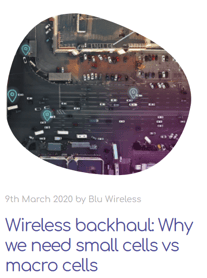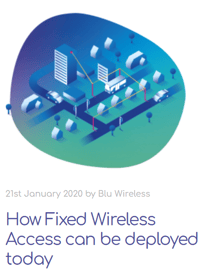When thinking of small cells, mobile phone operators like Vodafone and EE will probably come to mind first – while this is perfectly correct, most people don’t realise that this is just one part of the picture. In fact, mmWave small cells have far more uses that extend into many other elements of our society.
These service providers are utilising small cells to create 4G and 5G wireless networks for consumers, empowering our smart phones, helping us connect to social media apps, get internet access and more.
However, one important application of small cells, which tends to go unseen, is the creation of private networks for industrial applications. Small, low power mmWave distribution nodes stand out as an emerging technology that can support the creation of wireless mesh networks in indoor and outdoor areas, which can be implemented to address the connectivity needs of large private organisations, such as industrial plants.
Why do industries need private mesh networks?
The consumer 5G networks used for mobile data and WIFI send signals back and forth from a 5G small cell to a base station (or macro cell) roughly 200-300 metres away, ultimately enabling backhaul connections on mobile phones across the country.
In contrast, industries such as oil or gas refineries, need much higher data rates and mesh networking capabilities for their own private networks.
This is because an industrial complex or large factory could range over several kilometres, within which there will be hundreds of critical machines needing consistent monitoring using data rich technology. For example, the use of high resolution (4k) cameras is becoming commonplace, where each camera alone can generate up to 50 megabits of data – even with compression in place.
To manage such a vast amount of connections and data exchange taking place, industries therefore need to implement a private network with robust coverage and the high capacity needed to connect all of these devices to their core system. This allows them to monitor everything in real time, and record and analyse that critical data.
This kind of system requires multi-gigabit level performance, resilient connections and the capacity to hold high data rates as standard.
Related topics
Why use mmWave small cells?
Fibre cabling has the capability to provide this level of performance that industrial applications require, but in certain areas it’s not always accessible to achieve this. It can involve disruptive construction, digging, and often can’t be laid at all if the network area has obstructions such as rivers or pipework. In an industrial complex these kinds of obstructions are extremely common, and so other solutions need exploring.
By replacing fibre with small distribution nodes that use wireless connections, these private mesh networks can be achieved and tackle issues of obstructions or complex environments.
Using mmWave frequencies also enables the wireless connections to perform at a fibre-grade level. This is because the greater bandwidth available at mmWave frequencies can carry more data and at faster speeds.
Formed as a mesh network, these high-capacity wireless connections can connect to all devices in an industrial complex, allowing large amounts of data to be easily and quickly transferred back to the core network without the need for fibre.
Using a mesh network is particularly beneficial for multi-device networks; its ability to counteract interference and seamlessly re-route connections makes it more robust and reliable than a standard network. The flexible connections and small distribution nodes also make mesh networks easy to scale and expand as more devices are added.
What are the benefits of private mesh networks to industrial applications?
-
Easy Deployment
Deployment of mmWave distribution nodes for wireless private networks can be made using existing infrastructure, such as poles or walls, eliminating any large disruptions to operations and lowering cost of deployment.
-
Privacy and Security
In contrast to large mobile operators, private mesh networks are a completely independent system that only the factory or industrial complex can use. The privacy of this allows enhanced security to ensure sensitive data is contained.
-
License Exempt Band
Private networks built with mmWave nodes utilise the license exempt (or unlicensed) frequency bands, which come with several benefits; lower costs, low latency and higher bandwidth. The license exempt band function between 57-71GHz which offers 14GHz of available spectrum, which is the largest amount of continuous spectrum between DC and 100GHz available in the industry today.
The license exempt band is free to use whereas the licensed spectrum, which is what mobile operators function in, need to be paid for through a license fee. No extra costs attached for providers translates directly to lower costs for customers.
Therefore, for industrial complexes that require high-bandwidth solutions, a large amount of spectrum, and reliable security to connect multiple devices, private networks are an exceptionally well positioned option.
WHY BLU WIRELESS
Blu Wireless are cutting edge leaders in the high-speed wireless connectivity and communications industry. Operating in the 57-71GHz band for mmWave wireless communications, we can deliver the appropriate bandwidth and spectrum needed to build an effective, flexible and reliable private network.
We work with our customers to understand their requirements and can offer an array of solutions, from mmWave technology to the final product, simplifying the creation and deployment of your customised, fit-for-purpose network. As well as the hardware, such as the radio and modem, we uniquely supply the application software which integrates the private mesh network together.
This mmWave technology is the next step for industries and Industry 4.0. Without it, the creation of private networks that can seamlessly manage data from sensors, 4K video, digital intelligence and more won’t be possible in the near future.
To find out more about our mmWave technology and how it can be used for industry private networks, get in touch.











